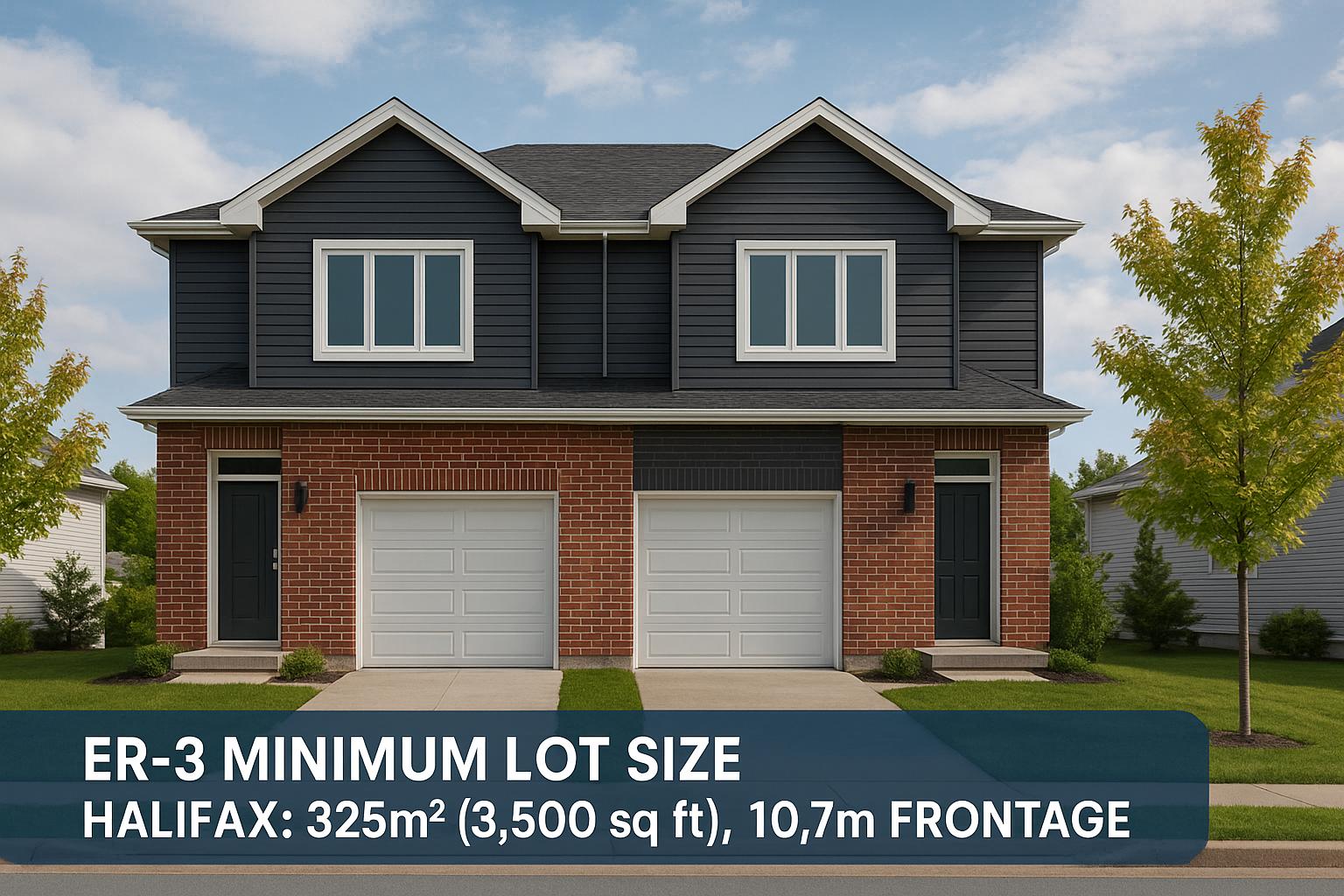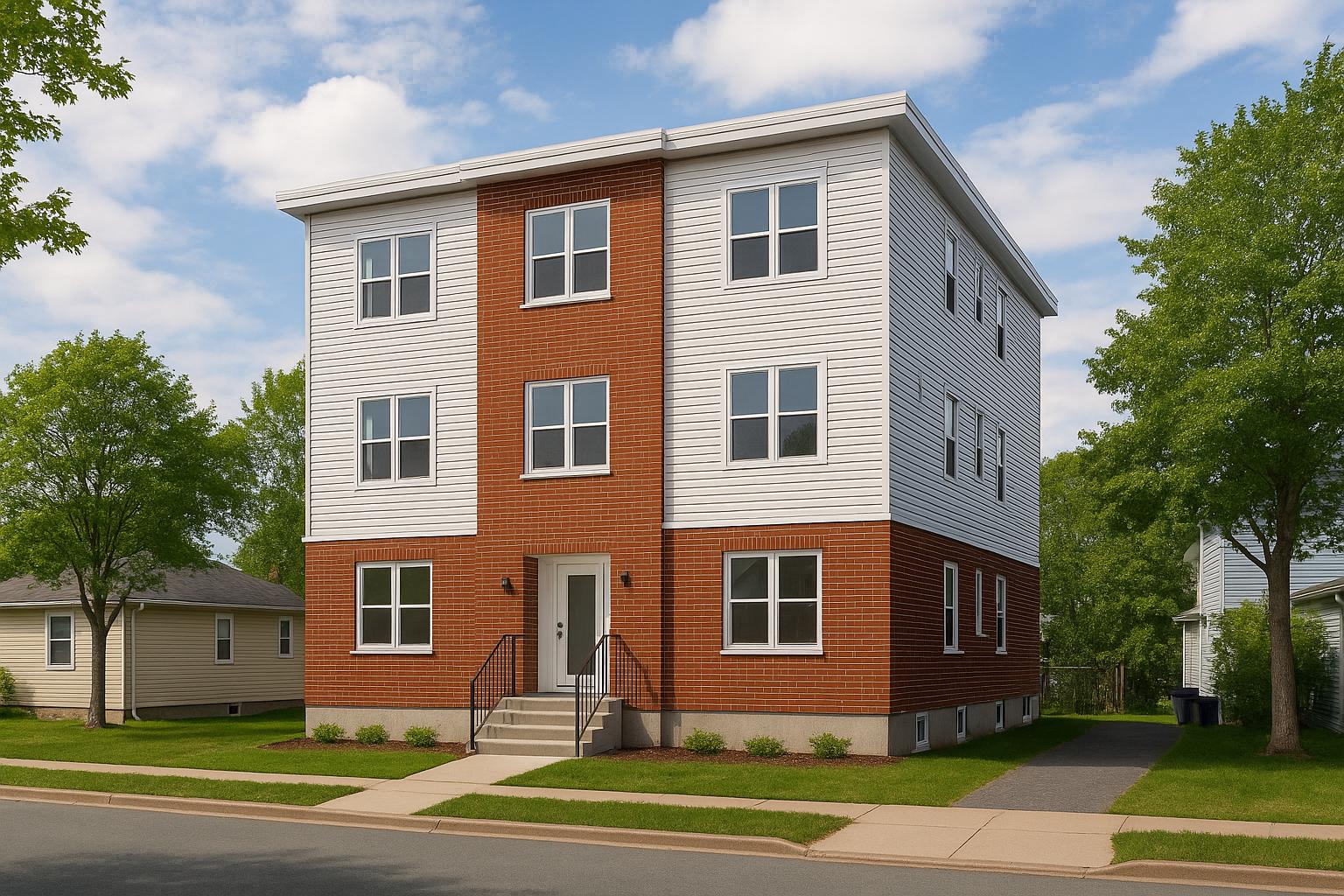Halifax’s ER-2 zoning allows property owners to build up to two main dwelling units and one backyard suite on a single lot. This zoning, part of the Centre Plan, is designed to address housing shortages by increasing density while maintaining neighbourhood character. ER-2 applies to areas near transit and community hubs, offering flexibility for single-family homes, semi-detached units, or townhouses. Backyard suites, introduced in 2020, provide additional rental income opportunities.
Key highlights:
- What you can build: 2 primary units (e.g., semi-detached or single-family with a secondary suite) + 1 backyard suite.
- Lot requirements: Minimum lot size of 325 m²; setbacks vary by area.
- Permits: Applications are submitted through Halifax’s online portal, requiring accurate documentation and fees (~$4,000 for secondary suites).
- No parking required: ER-2 zoning eliminates mandatory parking, offering more design flexibility.
This zoning balances housing needs with community character, making it a practical option for property owners looking to expand or generate rental income.
What You Can Build Under ER-2 Zoning
2 Primary Units Plus 1 Backyard Suite
Under ER-2 zoning, you can develop up to two primary dwelling units and one backyard suite on a single lot. This zoning offers a variety of options for property development.
The two primary units can take different forms. For instance, you could build a single-family home with a secondary suite, effectively dividing the home into two separate living spaces. Alternatively, you might opt for a semi-detached dwelling, which features two separate units sharing a common wall but with independent entrances.
Additionally, you can add a backyard suite as a standalone unit. ER-2 zoning also allows for townhouse-style dwellings with up to four units in a row [1]. This is a great option for properties with enough frontage, enabling higher-density development while staying within zoning regulations.
Next, let’s see how ER-2 zoning compares to other residential zones in Halifax.
How ER-2 Compares to Other Zoning Types
To understand the potential of ER-2 zoning, it helps to see how it fits within Halifax's broader zoning framework. The Established Residential designation includes three zones, which are the lowest density zones in the Centre Plan [3].
| Zone | Primary Units Allowed | Additional Features |
|---|---|---|
| ER-1 | Single-unit dwellings only | Secondary suites, backyard suites |
| ER-2 | Single, two-unit, semi-detached | Secondary suites, backyard suites, townhouses (up to 4 in a row) |
| ER-3 | Single, two-unit, semi-detached, three-unit | Secondary suites, backyard suites, townhouses (up to 8 in a row), four-unit dwellings |
ER-2 zoning strikes a balance between density and flexibility. While ER-1 restricts you to just one primary unit, ER-2 doubles that capacity. ER-3, on the other hand, allows for even greater density, including three-unit and four-unit dwellings, as well as larger townhouse developments.
All three ER zones permit home occupations, daycares, bed and breakfast operations, and urban agriculture [3]. This means an ER-2 property can serve both residential and supplementary purposes, offering a lot of versatility.
Backyard Suite Rules and Requirements
Backyard suites, which have been permitted as accessory units since 1 September 2020 [4], provide an excellent opportunity for rental income while ensuring tenant privacy. These suites can either be built above an accessory structure, like a garage, or as standalone buildings [4].
To build a backyard suite, you’ll need to apply for a construction permit [4]. Permit fees for secondary suites generally run around $4,000, so be sure to account for this in your budget [5]. The rules for backyard suites apply across most of the Halifax Regional Municipality in areas zoned for single-detached homes, duplexes, semi-detached homes, and townhouses [4].
For more details on obtaining permits for backyard suites, visit halifax.ca or call 311 [4].
2459 Davison Street, Halifax, Nova Scotia Presented by Assist 2 Sell, HomeWorks Realty Ltd..

Design and Building Requirements
Understanding the design rules for ER-2 zoning can help you make the most of your property's potential.
Lot Size and Setbacks
ER-2 zoning comes with specific rules about lot dimensions. For properties with 1–4 units, the minimum lot size is 325 square metres, and the width must be at least 10.7 metres. Setback requirements - how far buildings must be from property lines - depend on the neighbourhood. Typically, the minimum setback is 1.25 metres, though it can go as low as 0.5 metres in some areas and up to 4.5 metres in others. As for lot coverage, the maximum is generally 40%, but in certain areas, it can range between 35% and 50% [3].
These rules are essential for creating functional layouts while aligning with other design standards.
Parking and Access Requirements
Parking and access are also important considerations under ER-2 zoning. One notable feature is the removal of mandatory parking requirements for ER-1, ER-2, and ER-3 zones [3]. This change allows for more flexibility, such as expanding living spaces or adding outdoor features. While parking isn't required, it's still worth thinking about tenant needs and the surrounding neighbourhood to ensure easy and safe access.
Getting Permits for ER-2 Projects
A well-prepared permit application is key to keeping your ER-2 project on track. By carefully following Halifax Regional Municipality (HRM) guidelines and ensuring all required documents are complete and properly formatted, you can navigate the permitting process more smoothly.
Step-by-Step Permit Process
HRM uses an online system called the Permitting, Planning, Licensing & Compliance (PPLC) portal for all permit applications. Before you dive in, take a moment to review HRM's "Before You Begin" checklist and instructional video. These resources will help you understand the requirements and avoid unnecessary hiccups.
Start by registering for a Customer Portal Account on the HRM website. If you're working with a contractor, you’ll also need to create a Contractor Profile. The Customer Portal Dashboard will serve as your go-to place for tracking your application’s progress.
The application itself is user-friendly, with an interactive wizard guiding you through each step. Required fields are clearly marked, and you’ll need to provide location details like your Parcel Identification Number (PID) or civic address. If a contractor is involved, make sure to fill out the contractor section during this step.
Pay close attention to document preparation. All required files must be uploaded directly to the portal - no emailed or mailed documents will be accepted. Files need to be under 100MB, in formats like Word, PDF, or JPEG, and must follow HRM's naming conventions. Avoid using zipped or password-protected files. Also, make sure to pay all application fees in full when submitting your application.
Once your application is submitted, you can track its status in the Customer Portal. If anything is missing or incorrect, your application will be sent back for corrections, so double-check everything before hitting submit.
Now, let’s explore common pitfalls and how to avoid them.
Common Delays and How to Avoid Them
Several factors can slow down the permit approval process, but being proactive can help you sidestep these issues.
First, ensure all your documents are accurate, properly formatted, and included in your submission. Missing or incorrect paperwork is one of the most common reasons for delays.
Working with professionals who are familiar with Halifax’s design standards can also save time. These experts can ensure your plans meet municipal expectations, reducing the likelihood of revisions [6].
Another potential hurdle is public opposition. Neighbours sometimes raise concerns about new projects, which can lead to formal objections and delays. Engaging with your community early in the planning process can help address concerns and build support for your project [7].
Economic conditions can also impact zoning and planning timelines. For example, during economic downturns, outdated zoning plans may create additional challenges. Staying informed about policy changes and municipal priorities can help you adjust your plans and timeline accordingly [7].
For even greater efficiency, consider an integrated approach to your project.
How Integrated Design-Build Speeds Up Permits
Traditional project approaches often involve separate teams of architects, engineers, and contractors working independently. This lack of coordination can lead to errors, delays, and costly revisions. An integrated design-build approach tackles these problems head-on by fostering collaboration and open communication from the start [8].
"How can I make this better for the person sitting across from me?" – Whit Noxon, Associate Director of Architecture, Ryan Companies [8]
With design and construction teams working together early in the process, potential permit issues can be identified and resolved during the design phase. This not only speeds up decision-making but also ensures compliance strategies are more effective.
Open communication among team members allows for creative problem-solving and improvements before the permit application is even submitted. By addressing potential challenges upfront, you reduce the chances of municipal reviewers requesting changes later on.
Another advantage of the integrated approach is the ability to learn from past projects. Teams can refine their processes and apply lessons learned to future applications, making them better equipped to meet HRM's specific requirements [8].
A great example of this approach in action is Helio Urban Development in Nova Scotia. By bringing planners, architects, engineers, and construction teams together under one roof, they eliminate many of the coordination challenges that typically slow down projects. Their methodical process - starting with a deep understanding of permit requirements - helps avoid delays that can stretch traditional project timelines from 8 months to over 18 months.
sbb-itb-16b8a48
Getting the Most Value from ER-2 Zoning
Once you've tackled permit and design strategies, the next step is figuring out how to maximize your ER-2 property's rental income. Halifax's rental market is ripe with opportunities for property owners who know how to make the most of their ER-2 zoning benefits. With the city's population surpassing 500,000 in 2024 and a housing shortage nearing 18,000 units, the demand for quality rental housing is only growing stronger [2][9].
Maximizing Rental Income
To boost rental income, it's crucial to understand the local market and focus on attracting the right tenants. Units priced under $1,300 per month have vacancy rates below 1%, highlighting a clear demand for affordable yet high-quality housing [9].
Target groups like working professionals and students who are looking for clean, safe, and modern accommodations. The average rent across all unit sizes in Halifax reached $1,538 in 2023, with two-bedroom units averaging $1,707 in 2024. These numbers signal strong earning potential for property owners who can deliver the quality tenants expect [9].
When deciding on your unit mix, keep in mind that rental rates for units that turned over rose by an average of 28% in 2024. This makes it even more important to attract and retain reliable tenants [9]. Location is another key factor - areas like Dartmouth North offer more affordable options with average rents around $1,246 and extremely tight vacancy rates [9]. Properties near planned transit lines, universities, or major employers are especially attractive for long-term rental growth.
Don't overlook the potential of backyard suites, a feature allowed under ER-2 zoning. These stand-alone units provide privacy and outdoor space, making them appealing to tenants and capable of commanding competitive rents. Similarly, secondary suites within the main building offer another income stream without requiring additional parking [4].
Once you've focused on rental dynamics, the next step is managing construction costs to ensure solid returns.
Construction Costs and ROI Planning
Maximizing rental revenue starts with keeping construction costs in check and planning for strong returns. Halifax's multi-family properties offer yields in the low-5% range, making cost control a top priority [9].
One way to manage costs is through fixed-price contracts, which eliminate the 30–60% overruns often seen with cost-plus models. These contracts provide more accurate ROI projections and simplify financing.
Consider leveraging CMHC MLI Select financing to improve your returns. Although this program comes with higher costs - around $200,000 per unit - it allows for 95% financing with only a 5% down payment and provides a 50-year amortization period. This structure can significantly shift your leverage ratio, potentially making your project cash flow positive from the start.
Government incentives also play a big role in boosting ROI. The federal government has removed the 5% GST on qualifying purpose-built rental developments, and Nova Scotia has eliminated the 10% provincial portion of HST on new apartment projects [9].
Time is money when it comes to construction timelines. Every month of delay reduces potential rental income. For example, with average two-bedroom rents at $1,707, a three-unit ER-2 project could lose about $5,121 in revenue for each month of delay [9]. This makes securing timeline guarantees essential for protecting your investment.
Integrated vs Traditional Construction Methods
The construction method you choose can significantly impact both the cost and timeline of your ER-2 project. Opting for an integrated design-build approach over traditional construction can make a big difference.
| Aspect | Traditional Construction | Integrated Design-Build |
|---|---|---|
| Project Coordination | Multiple independent professionals | Single team with aligned objectives |
| Budget Certainty | Cost-plus model with 30–60% overrun risk | Fixed-price contracts with guaranteed costs |
| Timeline | Typically 12–18 months | Approximately 6 months with penalties for delays |
| Accountability | Multiple contracts with potential finger-pointing | Single point of contact with clear accountability |
| Problem Resolution | Reactive approaches that incur extra costs | Proactive identification during the design phase |
Traditional construction involves separate contracts for architects, engineers, contractors, and trades, often leading to communication breakdowns, costly revisions, and delays. On the other hand, an integrated design-build approach brings all key players together under one contract. Early collaboration helps identify potential issues and streamline decision-making, keeping your project on track.
Research shows that integrated design-build fosters better collaboration and trust among team members, including engineers, architects, and contractors. This teamwork leads to smarter, faster, and more cost-efficient solutions, all while maintaining high-quality standards. This ensures your rental units meet the expectations of Halifax's competitive rental market, helping you attract and retain tenants with ease.
Key Points for ER-2 Property Owners
ER-2 zoning creates exciting opportunities for rental housing development in Halifax, especially with the city facing a demand for 52,000 new units by 2027. Add to that $79 million from the Housing Accelerator Fund, earmarked to create 15,000 units, and the potential for growth is clear [2]. If you own property in an ER-2 zone, there are some important factors to keep in mind.
What Property Owners Need to Consider
ER-2 zoning is designed to balance higher density with maintaining the character of existing neighbourhoods. Properties in these zones can include two main dwelling units - whether that's a two-unit building or a semi-detached home - and may also feature a backyard or secondary suite [3]. This flexibility makes ER-2 zones ideal for "missing middle housing", which fills the gap between single-family homes and large apartment buildings [11].
Be sure to review the design requirements for ER-2 zoning to ensure your project complies. These zones are typically found in established neighbourhoods with low-rise residential buildings [3]. In heritage conservation districts, ER-2 zoning may even allow larger homes to be converted into multiple units or to add backyard suites [2]. However, always double-check local regulations, as specific rules could vary by area.
Another factor to consider is Halifax's winter parking ban, which runs from December 15 to March 31 during snowstorms and street-clearing operations. Planning for sufficient off-street parking is a must [10].
Avoiding zoning disputes is also critical. Issues related to setbacks, density, or community impact can lead to costly and time-consuming delays. As one expert puts it:
"Zoning disputes are best to be avoided, as they are expensive and time-consuming for everyone involved" [12].
To sidestep these challenges, consult with experienced professionals early in the planning process.
Next Steps for Your ER-2 Project
To move your ER-2 project forward smoothly, start with a deep dive into the Centre Plan and Land Use By-law. These documents outline the regulations that apply to your property [3]. Keep in mind that requirements can vary significantly from one neighbourhood to another, so don’t assume a successful project on one ER-2 lot means the same approach will work elsewhere.
Think strategically about your unit mix. Adding a backyard or secondary suite can help you maximize rental income while staying within zoning limits [3]. It’s also wise to design your property to fit comfortably within height and setback restrictions, as pushing these boundaries could lead to permit delays.
When it comes to permits, clear communication is key. Many municipalities now provide a single point of contact for applicants, which can simplify the review process and help avoid confusion [13].
Community engagement is another important step. Concerns about property values, traffic, or neighbourhood character can lead to opposition from local residents [12]. As Kortney Dunsby, sustainable cities co-ordinator with the Ecology Action Centre, explains:
"It's really an opportunity to educate people on what more sustainable development patterns are, and what the benefits of those are" [2].
Finally, remember that zoning compliance is just the beginning. Your construction approach will play a big role in determining project timelines, costs, and overall returns. Work with professionals who understand ER-2 zoning and Halifax’s rental market to ensure your project is set up for success. Careful planning, open communication with the community, and assembling the right team will help you navigate the process smoothly and achieve your goals.
FAQs
What makes ER-2 zoning a good choice for property development in Halifax compared to ER-1 and ER-3?
ER-2 zoning in Halifax offers a balanced approach to housing density and variety. Unlike ER-1, which restricts development to single-family homes, ER-2 allows for two-unit dwellings, semi-detached homes, and townhouses. This zoning provides property owners with more options while still preserving the character of residential neighbourhoods.
In contrast to ER-3 zoning, which accommodates higher-density projects like small apartment buildings or up to eight townhouses, ER-2 focuses on moderate growth. With a height cap of about three storeys and fewer permitted units, ER-2 is a great fit for those who want to expand housing options without committing to large-scale developments. It’s a practical zoning choice for adding variety to properties without overwhelming the neighbourhood.
What are the best ways to manage costs and boost rental income under Halifax's ER-2 zoning rules?
Managing Construction Costs and Maximizing Rental Income in Halifax's ER-2 Zoning
If you're looking to make the most of Halifax's ER-2 zoning, efficient planning and smart design are key. This zoning allows for up to two main units and one backyard suite, offering a great opportunity to boost rental income. By carefully designing layouts and choosing energy-efficient materials and systems, you might face higher upfront costs, but you'll save on operating expenses in the long run.
It's also worth considering a builder who takes an integrated approach. This means one team handles everything, reducing delays, simplifying contracts, and providing clear accountability. This streamlined process can help you stay on budget and get the most out of your property while meeting zoning requirements.
What challenges might you face when applying for permits for backyard suites in Halifax's ER-2 zones, and how can you address them?
Navigating Permits for Backyard Suites in Halifax's ER-2 Zones
Getting permits for backyard suites in Halifax's ER-2 zones isn’t always straightforward. There are design and size requirements to meet, and the application process itself can take several weeks. One common hurdle is ensuring the suite’s footprint fits within zoning limits - typically between 70 to 93 square metres, or up to 80% of the main home’s footprint. On top of that, safety and design standards must be met.
To tackle these challenges, it’s crucial to have a solid understanding of the zoning rules. A well-prepared application with accurate plans and all required documentation can help avoid unnecessary delays. Don’t forget that securing the final occupancy permit is a must before the suite can be used. For a smoother process, consider working with professionals who know Halifax’s zoning and permitting system inside and out. Their expertise can save time and ensure everything stays on track with local regulations.
Related Blog Posts
- Halifax’s New Zoning Rules Explained: Up to Four Units on a Single Lot (What It Means for Builders)
- Secondary Suites and Backyard Homes in Halifax: Adding Value with New Housing Options
- Build 4-8 Units Halifax: ER-3 Height Limit 11 Meters Explained
- No Parking Required: Halifax ER-3 Removes Minimum Parking Rules



